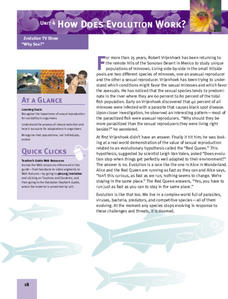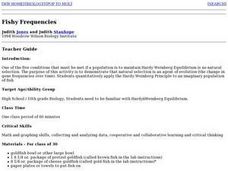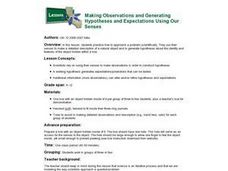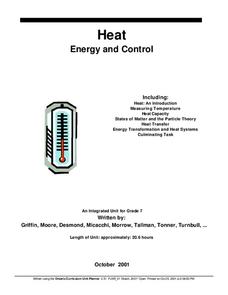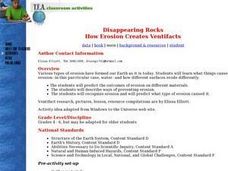Curated OER
Landforms: Geomorphology of Arkansas
Second graders create large, salt dough maps of Arkansas and the natural regions in the state created by geographical and morphological features.
Curated OER
Explore: 5th Grade Dissolved Oxygen
Fifth graders, in groups, use basic science process skills to measure and compare the dissolved oxygen levels and pH levels of distilled, stream, and pond water.
Curated OER
How Does Evolution Work?
Middle schoolers are introduced to how the process of evolution works. As a class, they review the characteristics of natural selection and how those with advantageous traits reproduce and survive. To test this theory of natural...
Curated OER
TE Activity: Survive That Tsunami!
Students examine the causes of tsunamis and observe a table top wave making machine. They make model houses while working in groups so that the can see how different construction types work. They discuss how engineers can design and...
Curated OER
TE Lesson: Land on the Run
Students study the causes of different types and speeds of landslides. They determine that landslides are the result of gravity, friction, and the materials involved. They examine the step engineers are taking to prevent and avoid...
Curated OER
Introducing the Use of Dichotomous Keys to Students
Middle schoolers are introduced to the use of dichotomous keys as a simple means of beginning scientific observations in nature. They comprehend how to use a dichotomous key. Students distinguish characteristics of a group of organisms....
Curated OER
Fishy Frequencies
Tenth graders demonstrate that natural selection is an agent of evolution. They quantitatively apply the Hardy-Weinberg Principle to an imaginary population of fish. They utilize math and graphing skills, collecting and analyzing data,...
Curated OER
Turkeys in the Cell--The Meiosis Square Dance
Young scholars identify synapsis as the key event in meiosis. They explain how synapsis leads to the formation of haploid gametes. Exploration of the differences between the processes of mitosis and meiosis occur. In accordance,...
Curated OER
Making Observations and Generating Hypotheses
Students practice how to approach a problem scientifically. They use their senses to make a detailed description of a natural object and to generate hypotheses about the identity and features of the object hidden within a box.
Curated OER
Let's Get Warm!
Young scholars investigate various methods that animals use to warm up in cold weather. They also explore the science principals involved. They then identify a human parallel, discuss what we can learn from nature, and create multimedia...
Curated OER
Endangered!
Young scholars research endangered species. In this ecology and literacy research lesson, students work with a partner to research an endangered species of their choice. Young scholars choose from a variety of presentation methods and...
Curated OER
Pond Succession Mural
Students recognize that natural environments are involved in a process of continual change, and create murals showing three major stages of pond succession. They review the idea of succession (the orderly, gradual, continual replacement...
Curated OER
Comparing and Collecting Bugs
Students differentiate between insects and non-insects. In this insects instructional activity, students review the attributes of insects and take a nature walk to look for insect homes. Students use resource books to identify the names...
Curated OER
The Cool Forms of Water
Learners discover the different forms of water on Earth. In this states of water lesson, students read material on the different forms of water and how they are created. The learners answer written questions on worksheets.
Curated OER
Seeds! What is Inside; How does it Grow and Why is it Important?
Students discover the importance of seeds in relationship to nature. In this plant growth lesson plan, students create a collection of seeds and discover the best type of environment to plant them. Students plant their own wheat seeds...
Curated OER
3-D Model of Lake Benthos
Students create 3-D models of Lake Benthos. In this scale drawing lesson, students create a 3-D model of Lake Benthos. Students work in groups to create the models. Students use the models to to encourage people to conserve natural...
Curated OER
Hawaii's Freshwater Ecosystems
Students examine brackish water. In this Science instructional activity, students observe organisms found in brackish water. Students record their observations of the various organisms.
Curated OER
Earth Day Lesson
Students analyze Earth science by answering environmental study questions. In this Earth Day lesson, students read the book The Lorax and identify the themes within it. Students define several recycling vocabulary terms and create an...
Curated OER
Static Electricity 1: Introducing Atoms
Students explore webpages to research the nature of atoms, including electrons, protons, and neutrons. This instructional activity is the first of a four-part series on static electricity. They see that static electricity involves + and...
Curated OER
Energy and Control
Seventh graders construct a lunch box that maintains functional temperature zones and does not allow heat transfer between the zones. They examine the transfer of heat, the capacity of certain materials to hold heat, and how the...
Curated OER
Disappearing Rocks
Learners explore the causes of erosion and observe how different surfaces erode differently. They recognize erosion and predict what type of erosion caused it. In addition, they predict the outcomes of erosion on different materials.
Curated OER
Basics of Archaeology
Young scholars identify what and how to complete an Archaeological excavation is conducted. They identify the transition from one layer to the next more easily if the colors of the layers are different. When creating a dig, the teacher...
Curated OER
Recycling
Third graders observe the importance of recycling. For this environmental lesson, 3rd graders will view experiments on water filtration, paper-making, and breathing pollutants, and will categorize recyclable materials.
Curated OER
Paleoclimates and Pollen
Students analyze soil for types of pollen to determine the probably climate conditions. In this earth science lesson, students make conclusions on what a climate is like based on soils samples. Students use a model soil...




